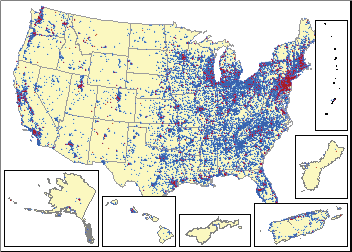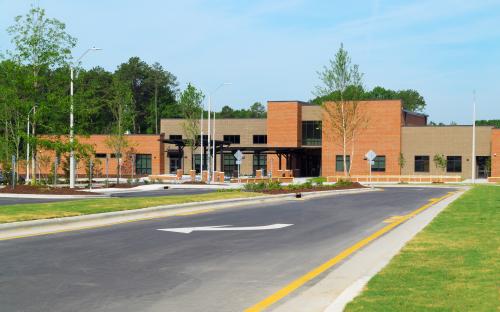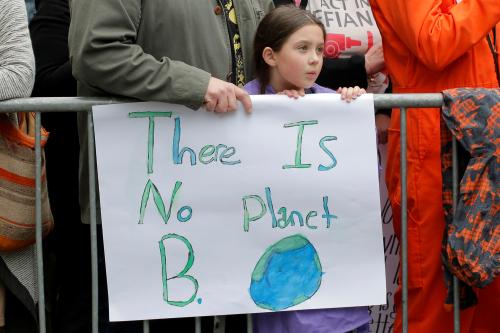Millions of tons of hazardous wastes have been produced in the United States in the last 100 years and have been dispersed into the air, water, as well as on and under the ground. Pollution is extremely widespread in the United States, as shown in Figure 1, which maps the location of two types of toxic waste sites in the United States in 2015.
Figure 1: Locations of Toxics Release Inventory and Superfund sites in the U.S., 2015

The blue dots show the location of Toxics Release Inventory (TRI) sites, which are factories or government facilities that are required to report their emissions to the Environmental Protection Agency (EPA) because they are using certain EPA-identified toxic chemicals. The red dots show the location of Superfund sites, which are the most contaminated federal toxic waste sites. Superfund sites are bad enough that the EPA puts them on a National Priority List, and if potentially responsible parties refuse to participate, the agency is ultimately responsible for cleaning them up.
Although we do not currently have comprehensive evidence on which pollutants are most harmful, the evidence we do have is worrisome and suggests a source of inequality that has not yet been explored in depth. Since African American, Hispanic, and low-income families are more likely to live in close proximity to sources of pollution like toxic waste and TRI sites, where housing is less expensive, it is possible that exposure to pollution is one mechanism through which poverty produces negative cognitive and health outcomes. I recently conducted three causal studies on this topic to assess the extent to which pollution exposure might affect children’s cognitive and behavioral outcomes.
Three new studies on how pollution affects child outcomes
In a new paper, I (along with David Figlio and Jeffrey Roth) use population-level data on all children born in the state of Florida between 1994-2002 to examine whether prenatal exposure to Superfund sites is associated with negative cognitive and developmental effects later in childhood. We compare siblings who faced different toxic exposures during gestation because the EPA cleaned the local Superfund site between the births of the two siblings. We find that prenatal exposure to Superfund pollution has long-term consequences on outcomes such as academic achievement, having behavioral incidents in school, repeating a grade, and even having a cognitive disability, compared with the unexposed sibling in the same family. The effects were relatively large in magnitude. Children living within two miles of an uncleaned Superfund site had a 23% increase in cognitive disabilities like learning disabilities, autism, intellectual disabilities, and speech and language impairments. They also had a 42% increase in the likelihood of being suspended from school and a 45% increase in the likelihood of repeating a grade, compared to the average for public school children in Florida. The effect on test scores was about one third to half of the estimated effect of being in a small class in the famous Project STAR experiment
In another new paper, I (along with Joanna Venator) explore what happens when a TRI site (a local factory or federal plant that emits harmful classes of pollution) opens or closes near a school. There are currently about 21,800 TRI sites operating across the United States, and the EPA estimates that 59 million people (about 19% of the population) live within one mile of a TRI site (EPA 2014). We find that nearly 22% of all public schools were within one mile of a TRI facility in 2016. Using detailed Florida public school data, we assess how children’s outcomes change when a TRI site opens or closes within a mile of their school. The comparison group is composed of students attending schools between one and two miles away from a TRI site at the same time in the same zip code.
We find that exposure to pollutants in schools has significant, negative impacts on test scores and being suspended or absent from school. We also find that a TRI site opening within one mile of a school is associated with lower performance on school accountability measures, meaning that there is an increase in the likelihood a school’s ranking drops one or more levels. These findings reveal that even short-term exposure to pollution causes test scores to drop. In addition, if schools are not fully in control of students’ test scores but still face rewards and sanctions for these scores, this raises important questions of fairness, particularly if the schools serving the highest fractions of Black or low-income children are the ones most affected by local pollution.
Finally, there is traffic pollution to consider. Over 6.4 million U.S. children attend public school within 250 meters of a major roadway. In another new working paper, I (along with David Simon and Jenni Heissel) compare students who have to switch from elementary to middle school or from middle school to high school as they progress through the school system. We compare children who switch from a school that is upwind from a highway to a school that is downwind of a highway, and find that highway pollution affects students’ test scores, behavior, and absences. Children who attend school near a major highway are again more likely to be low income or minority than children attending school elsewhere.
Implications for policy and practice
These findings have strong implications for where we locate schools, playgrounds, public housing, and places children or pregnant women congregate. For a long time, we have known that neighborhoods matter to children’s long-term outcomes. However, we are learning a lot more recently about the effects of pollution from studies of school bus emissions, poor air quality, and lead poisoning on children’s educational outcomes. We are starting to realize that pollution is one major reason why neighborhoods matter—that pollution might drive more inequality than we are comfortable with, and that the true costs of pollution are only beginning to be understood.







Commentary
How exposure to pollution affects educational outcomes and inequality
November 20, 2019